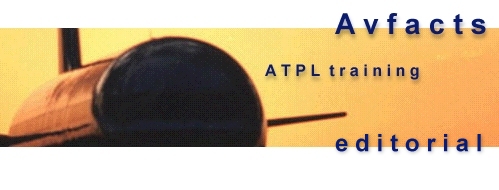




 |
 |
  |
 |
Aircraft Systems Topic 9.
The Conventional
Radio Magnetic Indicator
(RMI)
| General:
This instrument is found in most airliner cockpits, and quite a few turbine powered light aircraft such as the Beechcraft King Air, Cessna Conquest etc. It is basically a combination of the fixed card ADF, and the Direction Indicator (DI), and it affords a better presentation of your bearing to, or from the ground beacon. It can be tuned to either a VOR, or an NDB ground beacon and usually two needles (called 1 & 2). Either needle can be set to VOR or NDB. Orientation: The needle heads point TO the ground station, the tail representing the bearing of the aircraft FROM the station. In the diagram, needle 1 (the yellow one) is tuned to a VOR station, and the bearing TO the station is 015 magnetic. The aircraft’s bearing FROM the station (called a radial) is 195 magnetic. To fly TO the VOR, the pilot would hold a heading of 015 magnetic in nil wind conditions. Needle 2 is tuned to an NDB. The track TO the NDB is 345 magnetic. When talking of the aircraft bearing from an NDB we use the term “bearing FROM” the station. The aircraft’s bearing from the NDB is 165 magnetic. The compass card is automatically and continuously aligned with magnetic north at the aircraft location by means of a detector in the wing or tail, called a “flux valve” (also referred to as a “flux gate”). This saves you as pilot of the need to regularly check that the is aligned with the magnetic compass, something you would normally do every 15 minutes in an aircraft not fitted with a flux valve. Flux valves will be the subject of another training editorial in the near future. Refer to the diagram for display information.
Item a: In this case 53.3 nm. Item b: Item c: Item d: Item e: Item f: Item g: Item h: Item i: Item j: Points to note: 1. The RMI does NOT need a TO/FROM flag as does the VOR and HSI, as there is no 180 degree ambiguity. The aircraft is always on the tail of the needles. Bearing TO the station is that indicated by the head of the needles. 2. Modern airliners usually have an HSI and an RMI display for each of the two pilots. To ensure that one RMI and one HSI are available in the cockpit following failure of one of the two flux valves, they are cross wired such that the Captains HSI is wired to the left flux valve, as is the First Officers RMI. The Captains RMI is wired to the right flux valve, as is the First Officers HSI. Should say the left flux valve fail, the Captain would lose heading information to his HSI, and the First Officer would lose his RMI. This type of wiring method is used to achieve redundancy, and is called “Bootstrapping”. I hope that this mini training editorial helps you in your studies. Further Airline Pilot training texts such as these are available at most pilot supply shops around Australia, or through the secure ONLINE SHOP at this website for those of you with plastic money. This editorial is in fact a condensed extract from the training textbook on "Flying Glass". A list of approved distributors is available within the Avfacts site. ATPL training course information is also available within the Avfacts website. Finally, good luck with your studies, and remember ... Pilots are the ultimate professionals - strive to be one ! Best Wishes Rob Avery
|
![]()